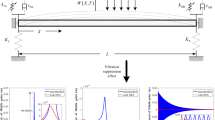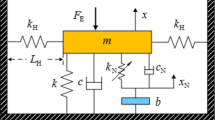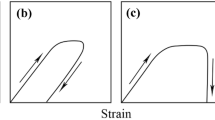Abstract
Large net structures used in engineering can easily get into vibration under external excitations; however, the corresponding vibration control strategy still remains challenging. In this paper, a wave boundary control (WBC) strategy is proposed for the vibration suppression of large net structures. The stability of the controlled structures is confirmed by using inverse Fourier transform, transfer function analysis, and numerical simulation. When WBC controllers are set at all boundaries and excitations come from the boundaries, dynamic responses for all the strings of the net structures can quickly reduce to zero without any residual vibration. The effects of different observations, controls, and distributions of sensors on the control laws are discussed. As an application, a method for reducing the number of controllers for large net structures is finally proposed. The research provides theoretical guidance for vibration control of large net structures.













Similar content being viewed by others
References
Tibert, G.: Deployable Tensegrity Structures for Space Applications. Royal Institute of Technology, Stockholm (2002)
Zhang, Y., Li, N., Yang, G., Ru, W.: Dynamic analysis of the deployment for mesh reflector deployable antennas with the cable-net structure. Acta Astronaut. 131, 182–189 (2017)
Zhang, W., Liu, T., Xi, A., Wang, Y.N.: Resonant responses and chaotic dynamics of composite laminated circular cylindrical shell with membranes. J. Sound Vib. 423, 65–99 (2018)
Hu, H., Tian, Q., Zhang, W., Jin, D., Hu, G., Song, Y.: Nonlinear dynamics and control of large deployable space structures composed of trusses and meshes. Adv. Mech. 43, 390–414 (2013)
Fuller, C.R., Elliott, S.J., Nelson, P.A.: Active Control of Vibration. Academic Press, London (1996)
Inman, D.J.: Control of Vibrations. Wiley, New York (2006)
Moshrefi-Torbati, M., Forrester, J.A., Forrester, A.I.J., Keane, A.J., Brennan, M.J., Elliott, S.J.: Novel active and passive anti-vibration mountings. J. Sound Vib. 331, 1532–1541 (2012)
Gawronski, W.K.: Advanced Structural Dynamics and Active Control of Structures. Springer, New York (1998)
Wang, Z., Li, T.: Optimal Piezoelectric sensor/actuator placement of cable net structures using H2-norm measures. J. Vib. Control. 20, 1257–1268 (2014)
Liu, F., Jin, D., Wen, H.: Optimal vibration control of curved beams using distributed parameter models. J. Sound Vib. 384, 15–27 (2016)
Mace, B.R.: Wave reflection and transmission in beams. J. Sound Vib. 97, 237–246 (1984)
Mace, B.R.: Active control of flexural vibrations. J. Sound Vib. 114, 253–270 (1987)
Flotow, A.H.Von: Traveling wave control for large spacecraft structures. J. Guid. Control Dyn. 9, 462–468 (1986)
Tanaka, N., Kikushima, Y.: Active wave control of a flexible beam (Proposition of the active sink method). JSME Int. J. 34, 159–167 (1991)
Tanaka, N., Kikushima, Y.: Flexural wave control of flexible beam: fundamental characteristics of an active sink system and its verification. Trans. Jpn. Soc. Mech. Eng. Ser C 56(530), 2575–2582 (1990)
Spadoni, A., Ruzzene, M., Cunefare, K.: Vibration and wave propagation control of plates with periodic arrays of shunted piezoelectric patches. J. Intell. Mater. Syst. Struct. 20, 979–990 (2009)
Wu, Z.J., Li, F.M.: Spectral element method and its application in analysing the vibration band gap properties of two-dimensional square lattices. J. Vib. Control. 22, 710–721 (2016)
Fujii, H.A., Watanabe, T., Taira, W., Trivailo, P.: An analysis of vibration and wave-absorbing control of tether systems. AIAA Guidance, Navigation, and Control Conference and Exhibit. AIAA2001-4033 (2001)
Wang, Z., Li, T.: Linear dynamic analysis and active control of space prestressed taut cable net structures using wave scattering method. Struct. Control Heal. Monit. 23, 783–798 (2016)
Meirovitch, L., Baruh, H.: On the problem of observation spillover in self-adjoint distributed-parameter systems. J. Optim. Theory Appl. 39, 269–291 (1983)
Logan, J.D.: Applied Mathematics. Wiley, New Jersey (2006)
O’Connor, W.J., Zhu, M.: Boundary-controlled travelling and standing waves in cascaded lumped systems. Mech. Syst. Signal Process. 39, 119–128 (2013)
Habibi, H., O’Connor, W.J.: Wave-based control of planar motion of beam-like mass-spring arrays. Wave Motion. 72, 317–330 (2017)
Kreuzer, E., Steidl, M.: Controlling torsional vibrations of drill strings via decomposition of traveling waves. Arch. Appl. Mech. 82, 515–531 (2012)
Rad, H.K., Salarieh, H., Alasty, A., Vatankhah, R.: Boundary control of flexible satellite vibration in planar motion. J. Sound Vib. 432, 549–568 (2018)
Krstic, M., Smyshlyaev, A.: Boundary Control of PDEs: A Course on Backstep. SIAM, Philadelphia (2008)
Wang, J., Tang, S., Pi, Y., Krstic, M.: Automatica Exponential regulation of the anti-collocatedly disturbed cage in a wave PDE-modeled ascending cable elevator. Automatica 95, 122–136 (2018)
Wang, J., Pi, Y., Krstic, M.: Automatica Balancing and suppression of oscillations of tension and cage in dual-cable mining elevators. Automatica 98, 223–238 (2018)
Zhao, Z., Wang, X., Zhang, C., Liu, Z., Yang, J.: Neural network based boundary control of a vibrating string system with input deadzone. Neurocomputing 275, 1021–1027 (2018)
Zhao, Z., Shi, J., Lan, X., Wang, X., Yang, J.: Adaptive neural network control of a flexible string system with non-symmetric dead-zone and output constraint. Neurocomputing 283, 1–8 (2018)
Zhao, Z., Liu, Z., Li, Z., Wang, N., Yang, J.: Control design for a vibrating flexible marine riser system. J. Frankl. Inst. 354, 8117–8133 (2017)
Zhao, Z., He, X., Ren, Z., Wen, G.: Boundary adaptive robust control of a flexible riser system with input nonlinearities. IEEE Trans. Syst. Man Cybern. Syst. (2018). https://doi.org/10.1109/TSMC.2018.2882734
Zhao, Z., He, X., Member, S., Ren, Z., Wen, G.: Output feedback stabilization for an axially moving system. IEEE Trans. Syst. Man, Cybern. Syst. (2018). https://doi.org/10.1109/TSMC.2018.2882822
Liu, Y., Zhang, K., Zhang, W.Z., Meng, X.Y.: Wave-based vibration control of large cable net structures. Wave Motion. 77, 139–155 (2018)
Guo, B., Shao, Z.: Stabilization of an abstract second order system with application to wave equations under non-collocated control and observations. Syst. Control Lett. 58, 334–341 (2009)
Tan, C.A., Ying, S.: Active wave control of the axially moving string: theory and experiment. J. Sound Vib. 236, 861–880 (2000)
Zingoni, A.: An efficient computational scheme for the vibration analysis of high tension cable nets. J. Sound Vib. 189, 55–75 (1996)
Elmore, W.C., Heald, M.a, Roelofs, L.: Physics of Waves. McGraw-Hill, Cambridge (1969)
Xu, X., Zuo, S., Zhang, K., Hu, G.: Wave-based transfer matrix method for dynamic response of large net structures. J. Sound Vib. 433, 265–286 (2018)
Doyle, J.F.: Wave Propagation in Structures. Springer, Berlin (1989)
Kovacic, I., Brennan, M.J.: On the use of two classical series expansion methods to determine the vibration of harmonically excited pure cubic oscillators. Phys. Lett. A. 372, 4028–4032 (2008)
Lax, P.D.: Weak solutions of nonlinear hyperbolic equations and their numerical computation. Commun. Pure Appl. Math. 7, 159–193 (2010)
Wang, L., Dongxu, L., Jianping, J.: General mesh configuration design approach for large cable-network antenna reflectors. J. Struct. Eng. 140, 04013051 (2014)
Liu, W., Lia, D.X., Jiang, J.P.: Mesh topological form design and geometrical configuration generation for cable-network antenna reflector structures. Struct. Eng. Mech. 45, 407–418 (2013)
Schek, H.J.: The force density method for form finding and computation of general networks. Comput. Methods Appl. Mech. Eng. 3, 115–134 (1974)
Acknowledgements
The authors thank Xinwei Xu for the help in the theoretical work. This work was supported by the National Natural Science Foundation of China [Grant Nos. 11290153 and 11672037].
Author contributions KZ proposed the key idea of this paper. SLZ and KZ developed the analytical method and carried out the numerical computation. YL assisted with the building of the numerical program. GKH assisted with discussing the results. SLZ, KZ, and GKH contributed to the writing of the paper.
Author information
Authors and Affiliations
Corresponding author
Additional information
Publisher's Note
Springer Nature remains neutral with regard to jurisdictional claims in published maps and institutional affiliations.
Appendices
Appendix A
Wave boundary control laws for the model in Fig. 3a:
The traveling waves at the boundary points can be expressed as
Thus, the frequency responses for Fig. 3a can be obtained as
Similarly, for the three controllers model in Fig. 4a, the control laws are
The traveling waves at boundary points for Fig. 4a can be expressed as
The time responses for the three controllers model in Fig. 4a are as follows:
The time responses for the four controllers model in Fig. 4b are as follows:
Appendix B
The total energy of the net structure is the sum of the kinetic and the energy of each string.
The energy of the string is as follows:
The space interval [0, L] is the length of the string and discretized into m equally spaced panels. By applying the trapezoidal rule to each panel, the approximation to the energy of this string (Eq. (B.1)) at time \(t_{q}\) becomes
After a summation of \(E(t_q )\) for all strings, we can obtain the total energy of the net structure at time \(t_{q}\).
Appendix C
The expression of the displacement of an arbitrary point on the string (see Fig. 1 or Fig. 8b) corresponding to different observations is shown in Table 2.
Rights and permissions
About this article
Cite this article
Zuo, S., Liu, Y., Zhang, K. et al. Wave boundary control method for vibration suppression of large net structures. Acta Mech 230, 3439–3456 (2019). https://doi.org/10.1007/s00707-019-02464-1
Received:
Revised:
Published:
Issue Date:
DOI: https://doi.org/10.1007/s00707-019-02464-1




